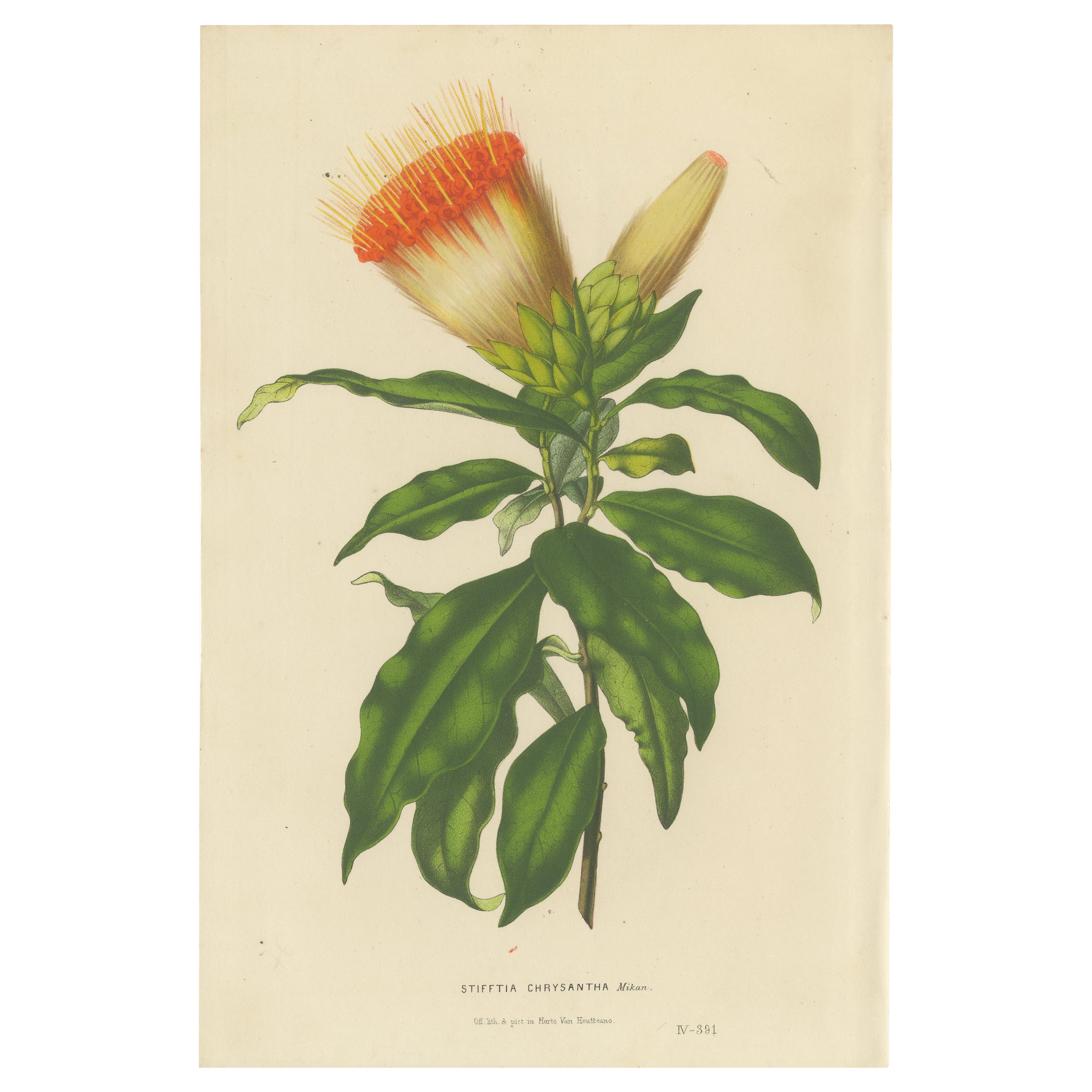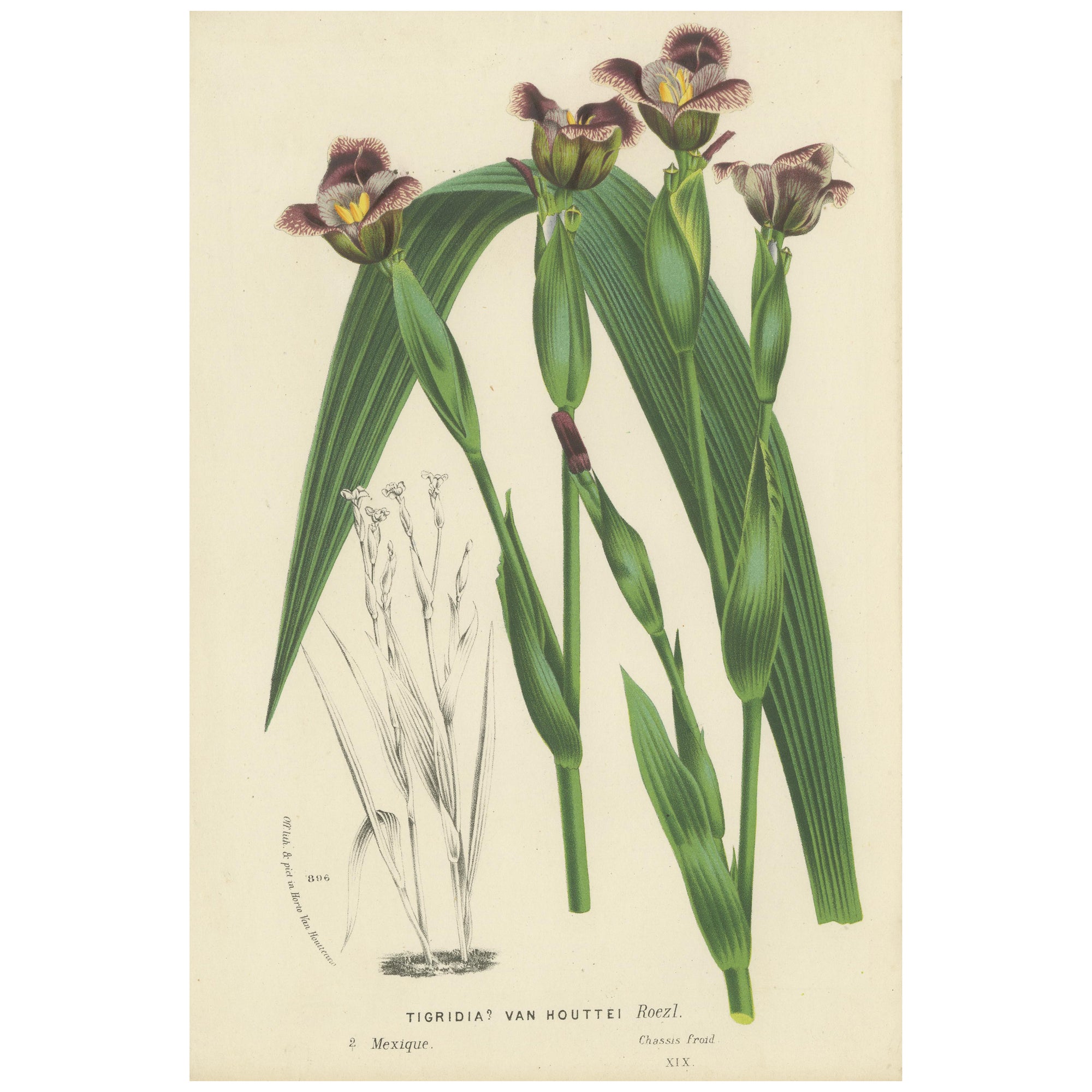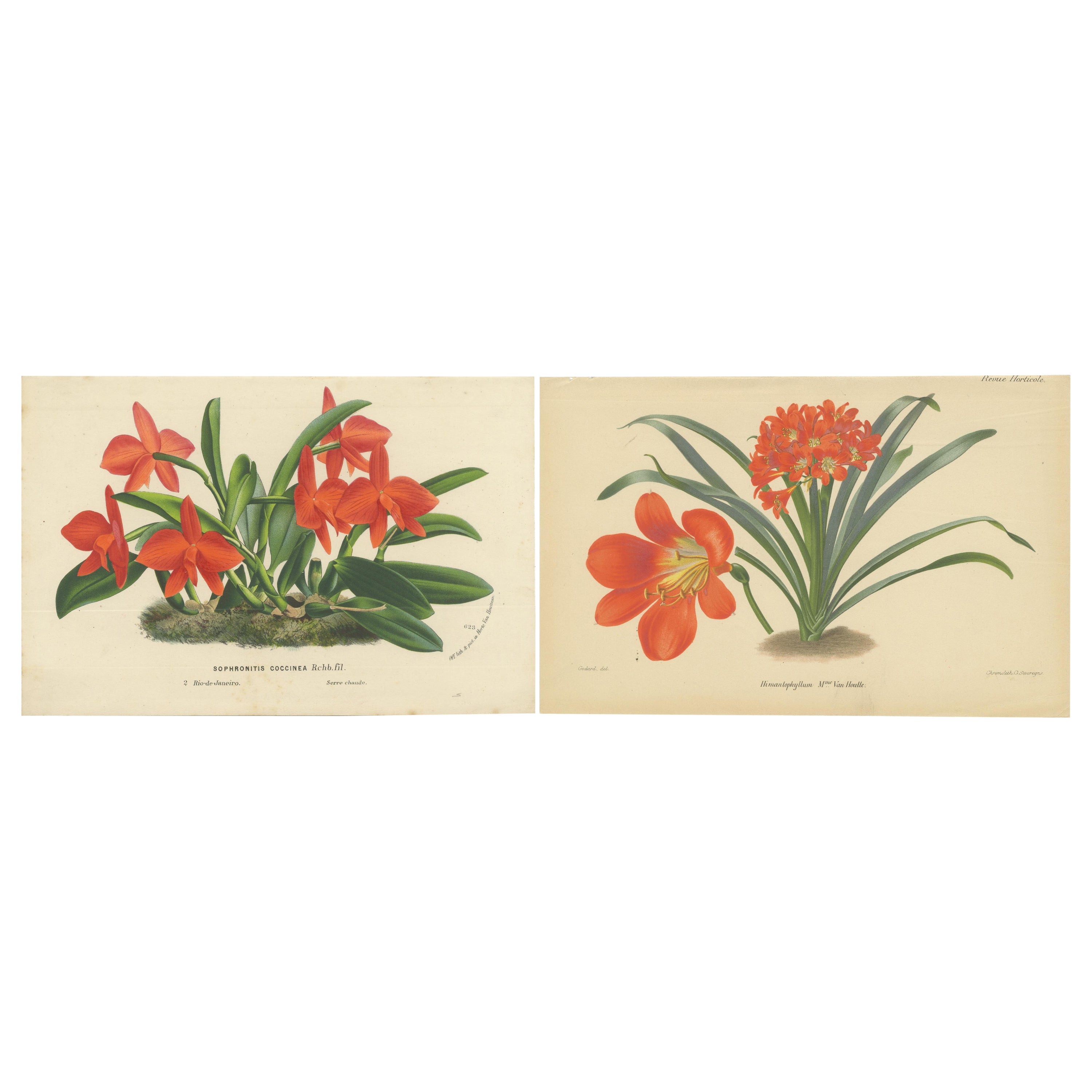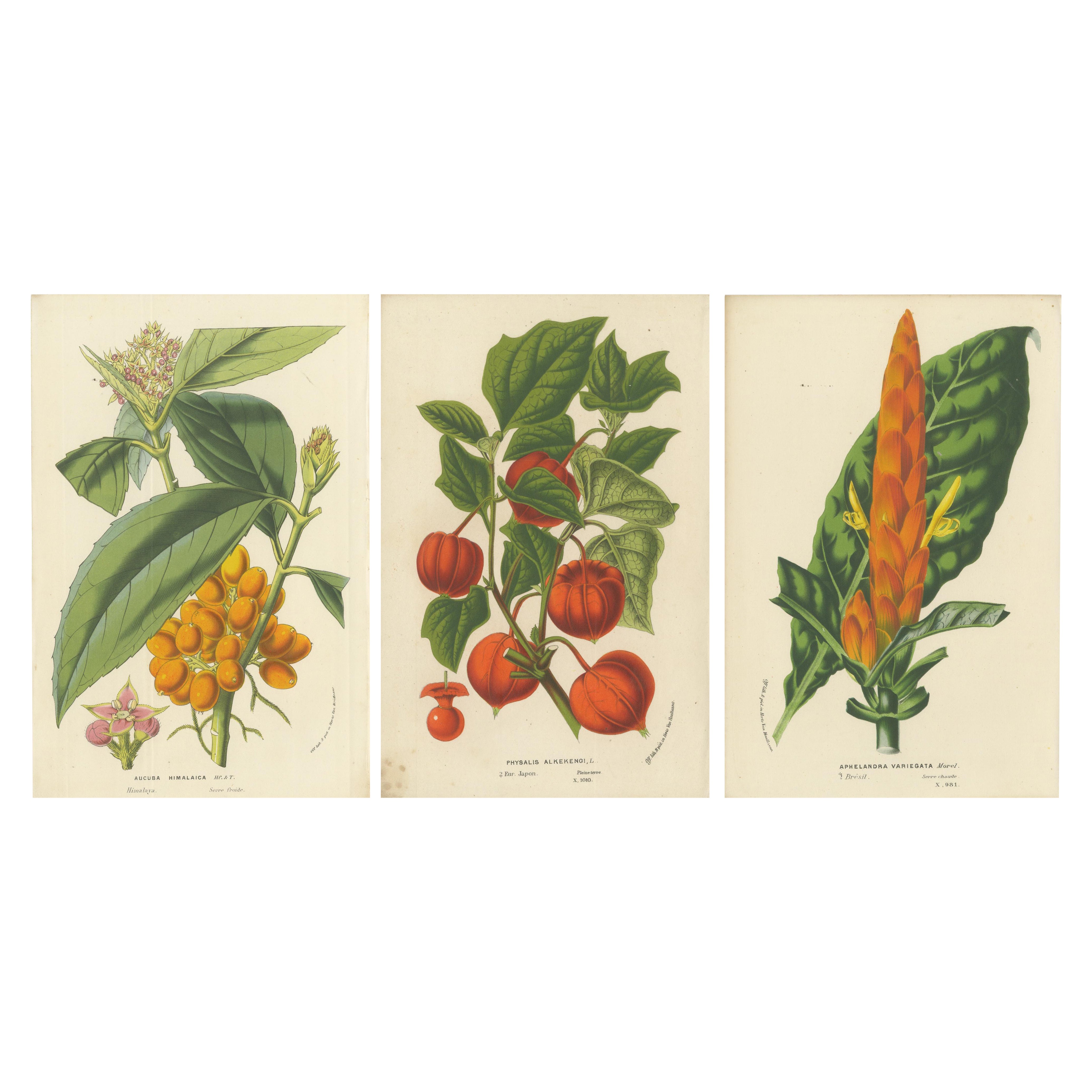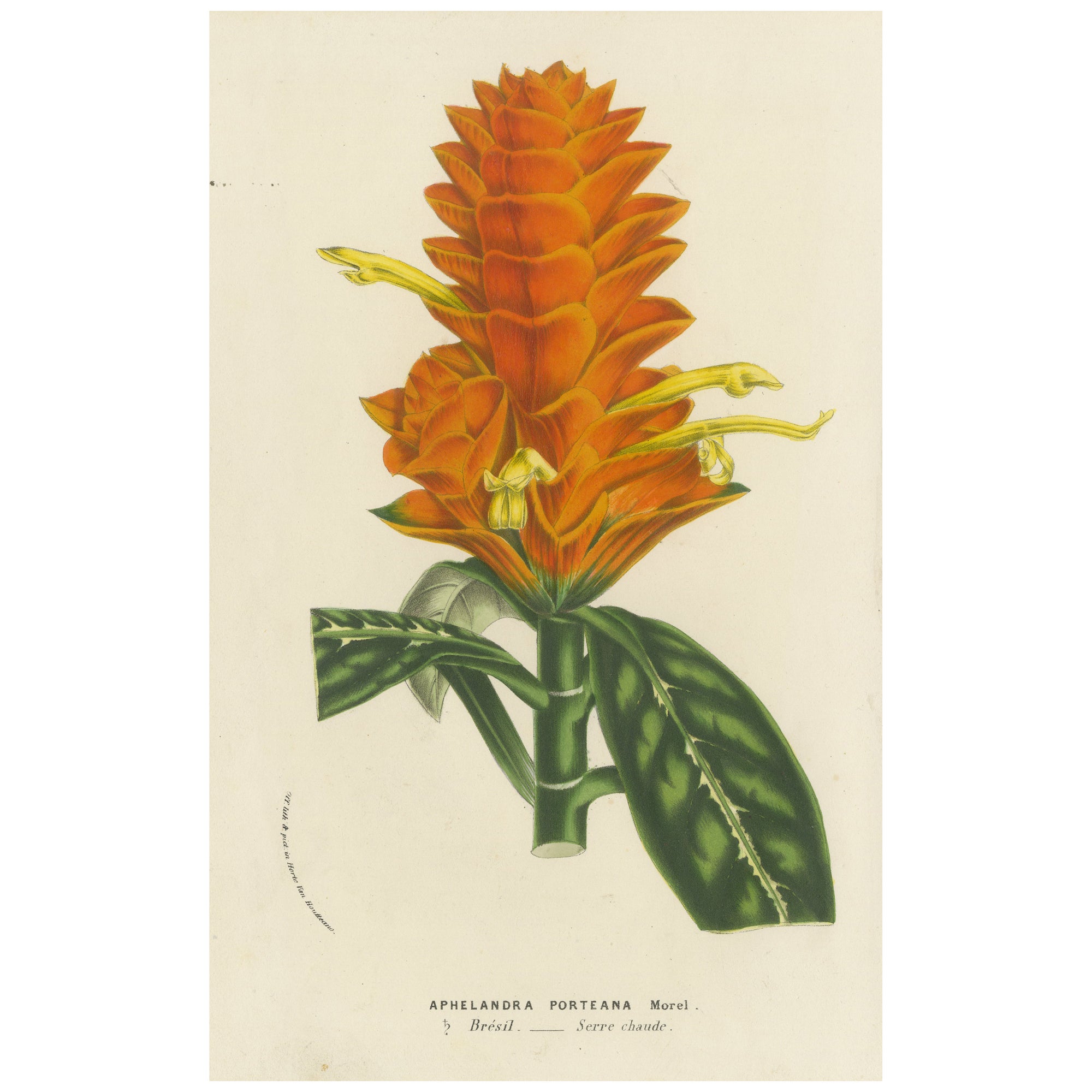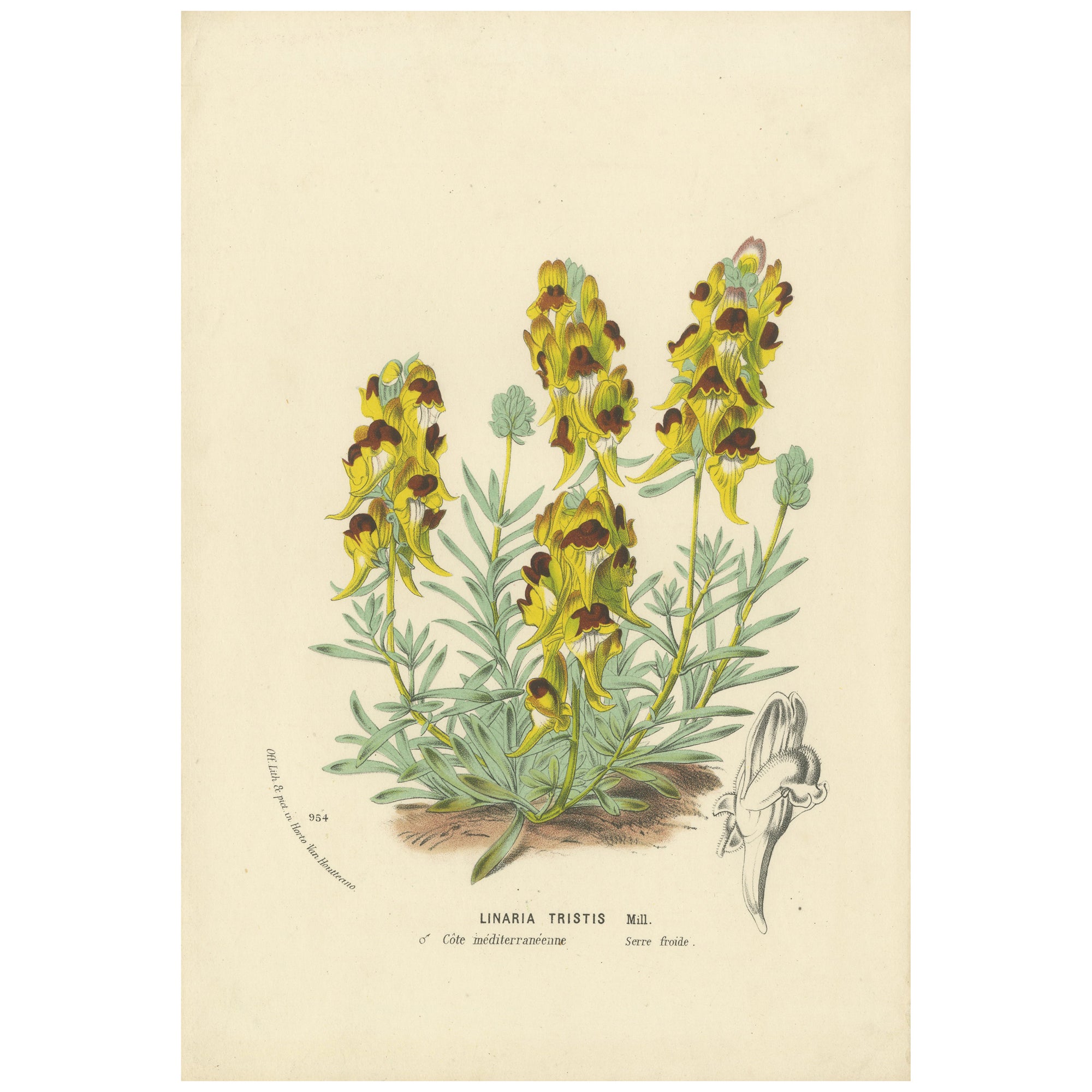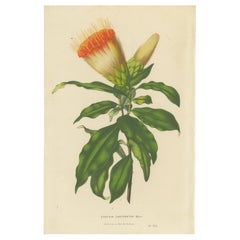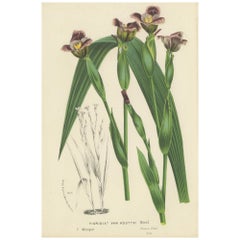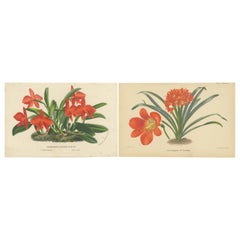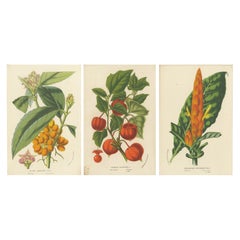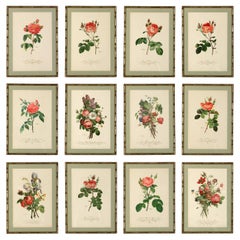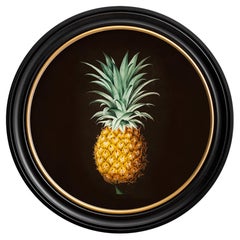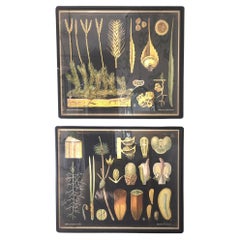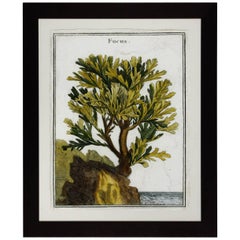Artículos similares a Enchanted Blossoms: Masterpieces of Botanical Art from Van Houtte's Florilegium
¿Quieres más imágenes o vídeos?
Solicita imágenes o vídeos adicionales al vendedor
1 de 7
Enchanted Blossoms: Masterpieces of Botanical Art from Van Houtte's Florilegium
Acerca del artículo
The plant depicted in the print on offer is Azalea mollis 'Glabrior', a variety of the Rhododendron species. Its common English name is the Smooth Azalea. This particular variety is noted for its lush, vivid orange flowers that can sometimes sport a reddish tint, making it a striking addition to any garden.
Description and Special Characteristics:
- Botanical Name: Azalea mollis 'Glabrior' Regel var.
- Origin: Native to Japan, this azalea is renowned for its robust growth and the spectacular display of large, trumpet-shaped flowers that bloom in magnificent clusters. The leaves are deciduous, dropping in the winter but providing a lush green backdrop during the flowering season.
- Flower Description: The flowers are particularly noteworthy for their size, vivid color, and the delicate patterning of freckles on the petals, which draw pollinators and admirers alike.
The Smooth Azalea is celebrated not only for its aesthetic appeal but also for its adaptability in temperate climates, making it a favorite among gardeners for both private gardens and public displays. The plant's ability to produce an abundance of flowers each spring, coupled with its relatively easy care, ensures its popularity in horticultural circles. Its vibrant color and full blossoms are often associated with the spring renewal, symbolizing peace and rejuvenation, which makes it a popular choice for many cultural and celebratory landscapes.
Context of the Botanical Print:
This beautiful botanical illustration comes from Louis Van Houtte's *Flore des Serres et des Jardins de l'Europe*, a work published between 1845 and 1883. Van Houtte, a premier horticulturist and nursery owner, featured plants like this Azalea in his catalog, which also functioned as an elaborate display of the most desirable plant species of the time. Orchids, roses, camellias, and other exotic plants were also highlighted, reflecting the Victorian era's fascination with botanical collections and the lush, vivid portrayal that chromolithography enabled.
This print not only serves as a historical document of horticultural interests and trends of the 19th century but also as a piece of art that captures the beauty and diversity of garden plants cultivated during Van Houtte's time. The condition of the print, as described, with minor marks typical for its age, suggests that it has been well-preserved, making it a valuable piece for collectors and enthusiasts of botanical art.
The botanical print of Azalea mollis 'Glabrior' comes from Louis Van Houtte's work, Flore des Serres et des Jardins de l'Europe, which was published over a span from 1845 to 1883. Given the style and the advanced chromolithography used in the print, it is likely from the latter part of this period. Therefore, a rough estimate would place the publication of this specific print towards the late 1870s or early 1880s. This timeframe would be consistent with the technological advancements and aesthetic styles represented in the print.
The technique used for the botanical print of Azalea mollis 'Glabrior' is chromolithography. This method was a revolutionary form of color printing from the 19th century that allowed for vibrant, multi-color illustrations. Chromolithography involves using multiple lithographic stones, each inked with a different color, to produce the final print. Each color requires a separate stone, and the meticulous alignment of these stones was crucial for achieving the detailed and vivid results characteristic of Louis Van Houtte's botanical illustrations. This technique allowed for high-quality, artistically appealing reproductions of original botanical artwork, making it highly popular for the illustration of prestigious works like *Flore des Serres et des Jardins de l'Europe*.
- Dimensiones:Altura: 16,3 cm (6,42 in)Anchura: 25 cm (9,85 in)Profundidad: 0,02 mm (0 in)
- Materiales y técnicas:
- Época:
- Fecha de fabricación:Circa 1875
- Estado:Condition: Good, given age. General age-related toning and/or occasional minor defects from handling. Colors are vivid, brownish around the edge, lower border cut short. Please study scan carefully.
- Ubicación del vendedor:Langweer, NL
- Número de referencia:Vendedor: BG-13761-121stDibs: LU3054341423772
Sobre el vendedor
5,0
Vendedor reconocido
Estos prestigiosos vendedores son líderes del sector y representan el escalón más alto en cuanto a calidad y diseño de artículos.
Vendedor Platino
Vendedores premium con una calificación de +4,7 y tiempos de respuesta de 24 horas
Establecido en 2009
Vendedor de 1stDibs desde 2017
2433 ventas en 1stDibs
Tiempo de respuesta usual: 1 hora
- EnvíoRecuperando presupuesto…Envío desde: Langweer, Países Bajos
- Política de devolución
Partes de esta página se han traducido automáticamente. 1stDibs no puede garantizar la exactitud de las traducciones. El inglés es el idioma predeterminado de este sitio web.
Garantía de autenticidad
En el improbable caso de que haya algún problema con la autenticidad de un artículo, ponte en contacto con nosotros en un plazo de 1 año para recibir un reembolso total. DetallesGarantía de devolución de dinero
Si tu artículo no es como se describe, sufre daños durante el transporte o no llega, ponte en contacto con nosotros en un plazo de 7 días para recibir un reembolso total. DetallesCancelación dentro de las 24 horas
Tienes un período de gracia de 24 horas para reconsiderar tu compra, sin preguntas.Vendedores profesionales aprobados
Nuestros vendedores de primera clase deben cumplir estrictos estándares de servicio para mantener la integridad de nuestros anuncios.Garantía de igualación de precios
Si encuentras que un vendedor publicó el mismo artículo por un precio menor en otro lado, igualaremos ese precio.Entrega global de confianza
Nuestra red de transporte de primera ofrece opciones de envío especializado en todo el mundo, que incluye envío personalizado.Más de este vendedor
Ver todoVellocino de Oro: Antigua y vibrante ilustración botánica de la colección Van Houtte
La huella es la planta Stifftia chrysantha, también conocida como Vellón Dorado o Cepillo Azafrán. Esta ilustración es una litografía en color de la obra de Louis Van Houtte "Flore d...
Categoría
Antiguo, Década de 1870, Impresiones
Materiales
Papel
La Tigridia de Van Houtte Ilustración botánica de Louis van Houtte, siglo XIX
La Tigridia de Van Houtte Ilustración botánica de Louis van Houtte, siglo XIX
Esta ilustración muestra la *Tigridia van Houttei*, conocida comúnmente como Tigridia de Van Houtte, un...
Categoría
Antiguo, Década de 1850, Impresiones
Materiales
Papel
Vibrant Orchid and Clivia: A Botanical Duo from Van Houtte's Collection, c.1875
The two prints are from Louis Van Houtte's "Flore des Serres et des Jardins de l'Europe" and illustrate two different species:
1. Sophronitis coccinea:
- Latin Name: Sophronitis ...
Categoría
Antiguo, Década de 1870, Impresiones
Materiales
Papel
La Elegancia Botánica de Van Houtte: Un Trío de Flora Exótica, publicado hacia 1875
Trío de Flora Exótica: Aucuba del Himalaya, Planta Linterna Japonesa y Acanto Brasileño
El fabricante Louis Van Houtte fue una figura muy influyente en la horticultura del siglo XIX...
Categoría
Antiguo, Década de 1870, Impresiones
Materiales
Papel
Litografía botánica del siglo XIX de Aphelandra Porteana por Louis van Houtte
Litografía botánica del siglo XIX de Aphelandra Porteana por Louis van Houtte
Ésta es una ilustración botánica de Aphelandra porteana, una planta conocida comúnmente como Planta Ceb...
Categoría
Antiguo, Década de 1850, Impresiones
Materiales
Papel
Lenteja de sapo 'Linaria Tristis' Ilustración botánica de Louis van Houtte, c.1850
Lenteja de sapo 'Linaria Tristis' Ilustración botánica de Louis van Houtte, siglo XIX
Esta ilustración botánica muestra *Linaria tristis*, conocida comúnmente como Lenteja de sapo, ...
Categoría
Antiguo, Década de 1850, Impresiones
Materiales
Papel
También te puede gustar
Serie de grabados botánicos franceses en marcos de bambú sintético
Por Pierre-Joseph Redouté, Jean Louis Prévost
Serie de grabados botánicos franceses de "Fleurs et Fruits" (Flores y frutas) creados por Pierre-Joseph Redouté y Jean-Louis Prevost, dos de los mejores artistas botánicos de princip...
Categoría
Antiguo, Fines del siglo XIX, Francés, Belle Époque, Impresiones
Materiales
bambú de imitación
Estudio botánico de la piña enmarcado Impresión del original francés de 1812, Nuevo
Ésta es una encantadora impresión redonda enmarcada de un estudio de una piña, originalmente de una ilustración botánica francesa de principios del siglo XIX coloreada a mano.
Los g...
Categoría
2.º década del siglo XXI, Británico, Georgiano, Impresiones
Materiales
Vidrio, Madera, Papel
Pareja de obras de arte botánicas alemanas enmarcadas del siglo XIX
Par De Botánicos Alemanes Del Siglo XIX Enmarcados En Frente De Cristal, Ambos Botánicos Enmarcados Están En Estado De Segunda Mano, Se Pueden Usar En Casa O En La Oficina,
Dimensio...
Categoría
Antiguo, Década de 1850, Alemán, Impresiones
Materiales
Vidrio, Madera
Grabado botánico de algas marinas del siglo XVIII de Natural Curiosities
Por Claude Aubriet, Joseph Pitton de Tournefort
Impresionante grabado de estudio botánico en color del siglo XVIII según Joseph Pitton de Tournefort (francés, 1656-1708) del alga Fucus, procedente de "Elements de Botanique", impre...
Categoría
siglo XX, Estadounidense, Victoriano, Impresiones
Materiales
Plexiglás, Madera, Papel
2200 US$ Precio de venta
Descuento del 21 %
Set De 4 Impresiones Botánicas Vintage, Inglesas, Grabados Enmarcados, Arte Floral, Decoración
Se trata de un conjunto de 4 estampados botánicos vintage. Estudio floral inglés enmarcado del siglo XVII, de finales del siglo XX, hacia 1990.
Atractivos estudios botánicos, con e...
Categoría
finales del siglo XX, Británico, Moderno de mediados de siglo, Impresiones
Materiales
Papel
"Les Essències de la Terra" de Joan Miró, una rara obra maestra del arte del siglo XX
Por Joan Miró
Adéntrate en el mundo vívido y onírico de Joan Miró con "Les Essències de la Terra", una impresionante litografía creada para su exposición de 1968 en la renombrada Sala Gaspar de Ba...
Categoría
Vintage, Década de 1960, Español, Moderno de mediados de siglo, Impresiones
Materiales
Papel
3424 US$ Precio de venta
Descuento del 25 %
